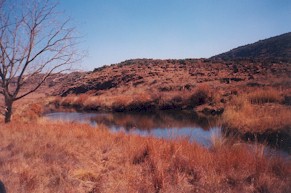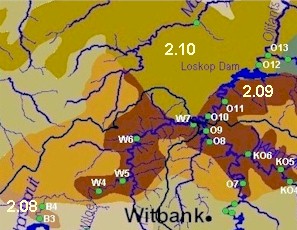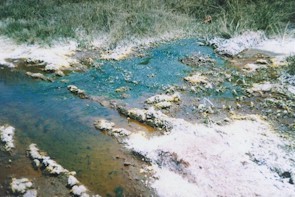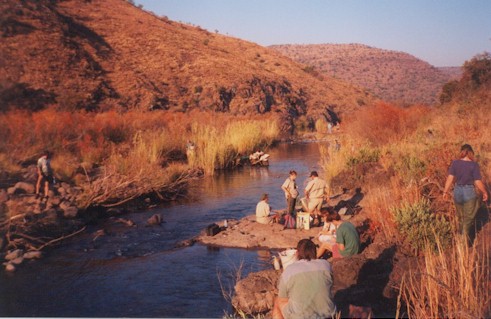|
Ecoregion and River Characteristics
This section of the Olifants River Catchment extends from the Highveld Plateau (2.08), descending the Drakensberg Escarpment (2.09) and bordering on the Bushveld Basin (2.10). The vegetation changes from highveld grassland to mixed bushveld with decreasing altitude (from 1 500 m to
1 000 m amsl). Mean annual precipitation decreases from 600-800 mm to 400-800 mm, and mean annual temperatures rise from 16-18°C to 18-20°C. Conglomerates, granites and quartzites predominate, as do shallow, rocky, sandy soils, across the ecoregions. In the upper parts, where wetlands are common, and threatened by mining for coal deposits, Working for Water, DEAT and Mpumalanga Parks Board have completed a wetlands inventory and prioritization for rehabilitation.
|
|
The confluence of the Olifants and
Klein Olifants Rivers takes place in ecoregion 2.09. From here the Olifants River flows in a north-westerly direction where it joins the Wilge River, upstream of the Loskop Dam. The Loskop Dam is situated at the lower end of a scenic gorge with high aesthetic value. The river varies from a single channel to multiple channels with afforested islands. Riverbanks are steep in some areas. Riparian vegetation is sparse, comprised of a few grasses and reeds. Rapids and pools are common, as are boulders and large rocks in the riverbed. Floodplains are narrow.
|

|
|
|
Present Ecological State
|
|

|
Ecoregion 2.08 & 2.09
This section of the Bronkhorstspruit is
good
to
fair
. The Wilge is in an overall
good
state and the state of the Klein Olifants is
fair
. The riparian habitats and vegetation of the Olifants River in this section are generally in
good
health. In-stream conditions are more variable, ranging from
good
to
fair
.
Ecoregion 2.10
This includes the Olifants River downstream of the Loskop Dam and the Moses River. In-stream habitat is in a
fair
state; fish
fair
to
poor
health, and invertebrates reflect
good
health. Riparian habitats and vegetation are in
fair
condition.
|
|
|
Drivers of Ecological Change (Land-use activities)
|
|
Ecoregions 2.08 and 2.09
Agricultural activities are mainly restricted to grazing, with limited influence on the riparian vegetation. Wattles are abundant, especially along the Klein Olifants River. Conditions improve upstream of the Loskop Dam and downstream of the Bronkhorstspruit Dam, which overflows regularly. Water quality in the Olifants River is negatively impacted by the high acidity and high concentrations of dissolved salts in some of the tributaries, especially the Klip River.
|

|
|
|
Ecoregion 2.10
Intensive irrigation of crops (including fruit trees) extends from the Loskop Dam to Marble Hall. The heavy abstraction of water that this causes may reduce the water available for ecological functioning downstream. Commercial agricultural activities reach up to the riverbanks. The clearing of ground cover associated with these activities increases the potential for erosion and sedimentation in the river channel. Alien vegetation is abundant. Pump houses and weirs impact negatively on the river ecology through changes to the flow regime. Aseasonal and ecologically insensitive releases from, or retention in, the Loskop Dam have an adverse impact on in-stream biological communities and cause erosion of the riverbed, through scouring.
Desired Ecological State and Response by Resource Managers
A
good
ecological state is desirable for the Wilge and Olifants Rivers. A large part of the Olifants River in this region lies in a scenic gorge with relatively high ecological importance and sensitivity. The desired ecological state for the Klein Olifants River and the Bronkhorstspruit is
fair
.
Wattles pose a threat to river health throughout these ecoregions. Their control or eradication is essential. The quality of the water in the Witbank Dam is poor, affecting the rivers downstream. The Klipspruit receives mine effluent and a long term management plan will be required to cope with the problem, because contaminant loads inherited from mining activities are likely to persist for many years.
The desired ecological state for the Olifants River downstream of the Loskop Dam is
fair
. A key step in achieving this is to determine the
Instream Flow Requirements (IFR) for the river and to manage water releases from the Loskop Dam accordingly.

|
|





|
|























